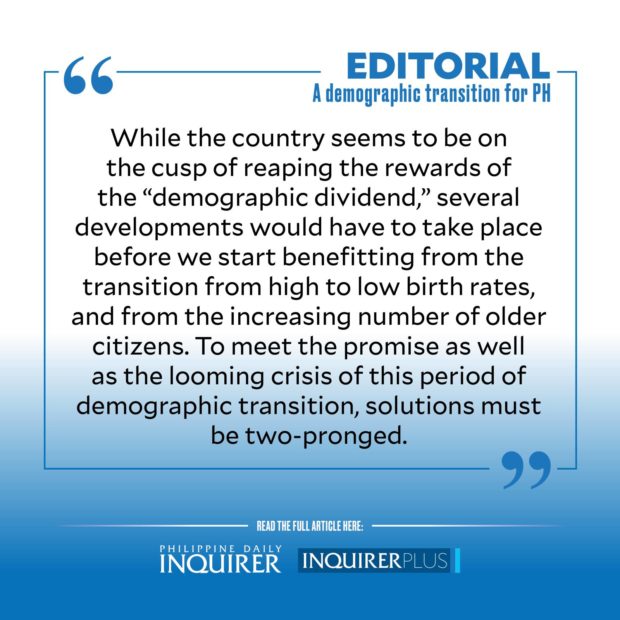A demographic transition for PH
In terms of demographics, or the study of “the social characteristics and statistics of a population,” local authorities say the Philippines is undergoing a “demographic transition.” This refers to the confluence of factors in which a population undergoes changes in size, age structures, and economics due to a shift from high to low birth rates, and the increasing number of the elderly population.
“The demographic transition,” says an authority in economics and demography, “has enabled economies to convert a larger portion of the gains … into growth of income per capita.”
In other words, the transition means “the reallocation of resources from the quantity of children toward their quality,” lessening the ratio of young dependents while increasing the number of productive adults, though leading as well to more aging dependents with their own special needs.
In many countries, the demographic transition has led to what is known as the “demographic dividend.” This is a growth in productivity resulting from more young adults being gainfully employed, as well as the redirection of resources away from basic needs like health, childcare, and basic education, to investments in productive endeavors and growing savings.
Such a transition is taking place right now in the country, according to the Commission on Population and Development (Popcom). Popcom Executive Director Juan Antonio Perez III said recently that the country recorded the lowest number of babies born in 34 years in 2020—the first year of the COVID-19 pandemic. The number of couples getting married also dropped to its lowest in two decades. There was a “significant drop” of 9.43 percent in the number of births registered last year, Perez said, bringing the number of so-called young dependents (those 15 years and below) to 30.7 percent of the population, compared to 37 percent in 2000.
But even as the number of young Filipinos “appears to be trending significantly lower in recent years,” said Perez, the number of elderly or senior citizens has been expanding.
The Popcom head sees a “silver lining” in the current situation. The “relatively large” existing pool of children aged five to 14 means that the country will see a growing number of productive young people up to 2035, “ensuring a robust and potentially effective workforce.”
“The situation we are seeing now has evolved in other countries in Europe, the Americas and lately in most of the West and Southeast Asian countries, a demographic transition which countries need to tackle with the correct population and development policies affecting the poor, young people and women,” Perez said.
On the other hand, the number of senior citizens age 60 years and above has doubled to 9.2 million in 2020, from 4.5 million 20 years ago. Their growing number, said Popcom, is “due to better health and socioeconomic conditions,” with today’s seniors “better educated and (living) healthier lifestyles.”
But, the population body warned, the impact of population aging presents “enormous and multifaceted” problems, especially for developing economies like the Philippines. Unchecked, an aging population could result in sluggish economic growth and fiscal sustainability, including a decline in tax revenues, increases in public expenditure, and the lack of an adequate welfare system.
And while the country seems to be on the cusp of reaping the rewards of the “demographic dividend,” several developments would have to take place before we start benefitting from the transition from high to low birth rates, and from the increasing number of older citizens.
To meet the promise as well as the looming crisis of this period of demographic transition, solutions must be two-pronged.
To ensure the productivity of the younger generation in the future, the educational system must address the shortcomings of the public school system, as evidenced by the poor showing of Filipino elementary students in regional and global comparative tests. Government needs to invest more to ensure a quality learning environment that includes more and better-equipped classrooms and facilities, better-paid teachers, more available learning materials like books and lab facilities, and even such basics as adequate lavatories and healthy canteen meals.
To prepare young people to join the workforce, they must also be oriented toward adjusting to the evolving demands of the job market, such as developing skills in new technologies. Government must also ensure that there would be jobs for them once they finish their formal education.
As for the elderly, the country must provide adequate material support for them apart from the pension given by the state-owned retirement bodies. Better and more affordable health care, especially the provision of maintenance medicines and medical procedures, is likewise necessary to prevent more serious and costly expenses down the line. Those deemed still active and productive could meanwhile be tapped for alternative income-generating work, such as trainers, advisers, part-time workers, and even paid caregivers.





















